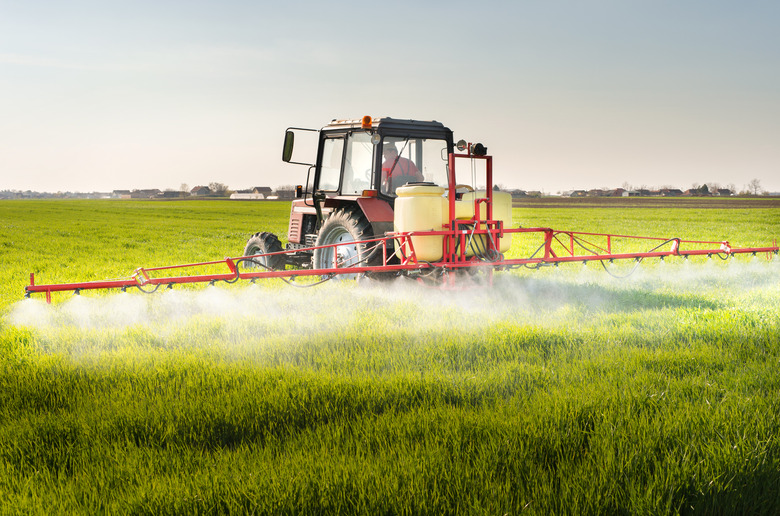Soil Pollution Types
Soil pollution includes any chemicals or contaminants that harm plant or animal species. These pollutants decrease soil quality, disturb the soil's natural balance and may also lead to wear and erosion. Different types of soil pollution can be distinguished by their source, as well as the effects each has on the ecosystem.
Agricultural Pollution
Many different agricultural processes contribute to soil pollution, which occurs both on the site itself and in nearby areas. Chemical fertilizers provide extra nutrients to increase crop yield, but also cause pollution that negatively impacts crops and soil quality over time. Pesticides kill insects that impact crop growth, but also harm animals and plants by contaminating the soil. Eventually, these chemicals seep into the soil and poison groundwater supplies. Rain and irrigation may also cause runoff that directs these chemicals to local waterways, or deposits them in the soil at other locations.
- Soil pollution includes any chemicals or contaminants that harm plant or animal species.
- Pesticides kill insects that impact crop growth, but also harm animals and plants by contaminating the soil.
According to the Indian Government's Department of Education, agricultural pollution decreases soil fertility, increases erosion and kills flora and fauna. It creates an imbalance in the soil that may prevent future farming in the area. The University of Minnesota recommends bio-fertilizers to enhance crop yield without contributing to soil pollution.
Urban Activities
Many everyday human activities lead to soil pollution, both directly and indirectly. Paving and development prevent proper drainage and increase runoff, which spreads construction-related contaminants to nearby land areas or streams. Increased waste disposal contaminates both landfills and public spaces. Trash that is improperly disposed of eventually breaks down into the soil, where it deposits any number of chemicals and pollutants into the earth. These pollutants may seep into groundwater or wash away into local waterways during a storm.
- According to the Indian Government's Department of Education, agricultural pollution decreases soil fertility, increases erosion and kills flora and fauna.
- Paving and development prevent proper drainage and increase runoff, which spreads construction-related contaminants to nearby land areas or streams.
Excess waste, regardless of where it is disposed of, increases the presence of bacteria in the soil. As these bacteria break down organic waste products, they generate methane gas that contributes to global warming and poor air quality. Decomposition of waste in the soil also creates foul odors that can impact quality of life.
Recycling offers an effective method of reducing waste and limiting soil pollution from urban activities.
Industrial Waste
According to the Indian Government Department of Education, 90 percent of soil pollution is caused by industrial waste products, while much of the remaining 10 percent comes from dry cleaning and gas station waste. When this waste is improperly disposed of, it contaminates the soil with harmful chemicals. These pollutants impact plant and animal species and eventually reach local water supplies, where they contaminate drinking water. Even when this waste is sent to regulated landfills, it releases toxic fumes that may harm nearby residents. These fumes also contain chemicals that can fall back to earth in the form of acid rain, which may damage soil and other objects across the entire region.
- Excess waste, regardless of where it is disposed of, increases the presence of bacteria in the soil.
- These fumes also contain chemicals that can fall back to earth in the form of acid rain, which may damage soil and other objects across the entire region.
Bioremediation is one method of removing industrial pollution from the soil, according to the University of Massachusetts. This technique requires cleanup crews to introduce healthy bacteria into the soil, where they gradually break down harmful materials and restore the balance of the soil.
